Tea meditation is a practice that combines mindfulness with the art of tea, allowing individuals to find inner calm and peace. It has its roots in ancient cultures, particularly in China and Japan, where tea has been used for centuries in meditation practices.
In this article, we will explore the history and origins of tea meditation, the benefits it offers for mindfulness, different tea meditation rituals and practices, and how to incorporate tea meditation into your daily routine.
Key Takeaways:
- Tea meditation combines mindfulness with the art of tea, promoting inner calm and peace.
- The practice has its origins in ancient cultures, such as China and Japan.
- Tea meditation offers numerous benefits for mindfulness and overall well-being.
- There are various rituals and practices for tea meditation, allowing individuals to find what resonates with them.
- You can easily incorporate tea meditation into your daily routine for regular moments of tranquility.
The History and Origins of Tea Meditation
Tea meditation has deep roots in ancient cultures, particularly in China and Japan. The Japanese tea ceremony, known as “chanoyu” or “sado,” is a highly ritualized form of tea meditation that emphasizes harmony, respect, purity, and tranquility. In China, tea has long been regarded as a sacred beverage used in meditation practices to cultivate mindfulness and inner peace. The history and origins of tea meditation can be traced back thousands of years, and the traditions and rituals surrounding it have evolved over time.
The Japanese Tea Ceremony: A Symbol of Harmony and Tranquility
The Japanese tea ceremony, or “chanoyu,” is a centuries-old cultural practice that encompasses much more than just the preparation and drinking of tea. It is a highly choreographed ritual that aims to create a serene and harmonious atmosphere, promoting a deep sense of presence and mindfulness.
“Tea is a work of art and needs a master’s hand to bring out its noblest qualities.”
– Sen Rikyu
Sen Rikyu, a renowned Japanese tea master, played a crucial role in shaping the Japanese tea ceremony as we know it today. His emphasis on humility, simplicity, and the integration of tea into daily life transformed the practice into an art form that cultivates inner peace and tranquility.
The Ancient Origins of Tea Meditation in China
In China, tea has a rich history that dates back thousands of years, with the earliest recorded evidence of tea consumption dating back to the 3rd century AD. During the Tang Dynasty (618-907 AD), tea became an integral part of Chinese culture, leading to the development of specific rituals and practices surrounding its consumption.
Tea and meditation have always been intertwined in Chinese culture. The preparation and serving of tea became a mindful practice, allowing individuals to focus their attention on the present moment and cultivate inner stillness.

Tea Traditions that Transcend Time
Throughout history, tea meditation has evolved and adapted to different cultures, resulting in various tea traditions around the world. Each tradition reflects the unique values, aesthetics, and philosophies of the particular culture in which it developed.
Sen no Rikyu once said:
“Though many people drink tea, if you do not know the Way of Tea, tea will drink you up.”
These words remind us that tea meditation is not merely about consuming tea but rather understanding and immersing ourselves in its essence. It is a practice that invites us to connect with the past, appreciate the present, and find inner calm amidst the chaos of everyday life.
Benefits of Tea Meditation for Mindfulness
Tea meditation offers a wide range of benefits for mindfulness. By engaging all our senses in the process of preparing and savoring tea, we become fully present in the moment, allowing our minds to quiet and our awareness to deepen.
The practice of tea meditation encourages a slower pace of life, providing an opportunity for self-care and introspection. It can help reduce stress, promote relaxation, and cultivate a greater sense of calm, clarity, and overall well-being.
When we approach tea meditation with intention and mindfulness, it becomes a powerful tool for managing stress and finding inner peace. With each sip, we connect with the flavors, aromas, and textures of the tea, engaging our senses and anchoring ourselves in the present moment.
Research has shown that tea contains natural compounds, such as L-theanine, which promote relaxation and reduce cortisol levels, a hormone associated with stress. By incorporating tea meditation into our daily routines, we can create a dedicated space for ourselves to unwind, reflect, and recharge.
Whether it’s a moment of solitude in the morning or a pause in the afternoon, tea meditation allows us to step away from the demands of life and focus on ourselves. It offers a respite from the constant noise and distractions, giving us the opportunity to be fully present with our thoughts and emotions.
Through tea meditation, we develop a deeper sense of self-awareness, cultivating a greater understanding of our needs, desires, and emotions. This heightened sense of awareness extends beyond the tea ceremony and permeates other aspects of our lives, enhancing our ability to stay grounded and mindful amidst the chaos.
With its numerous benefits for mindfulness and stress relief, tea meditation serves as a gentle reminder to slow down, take a breath, and appreciate the simple pleasures in life. It holds the power to transform a daily ritual into a meaningful practice that nourishes both the body and the soul.
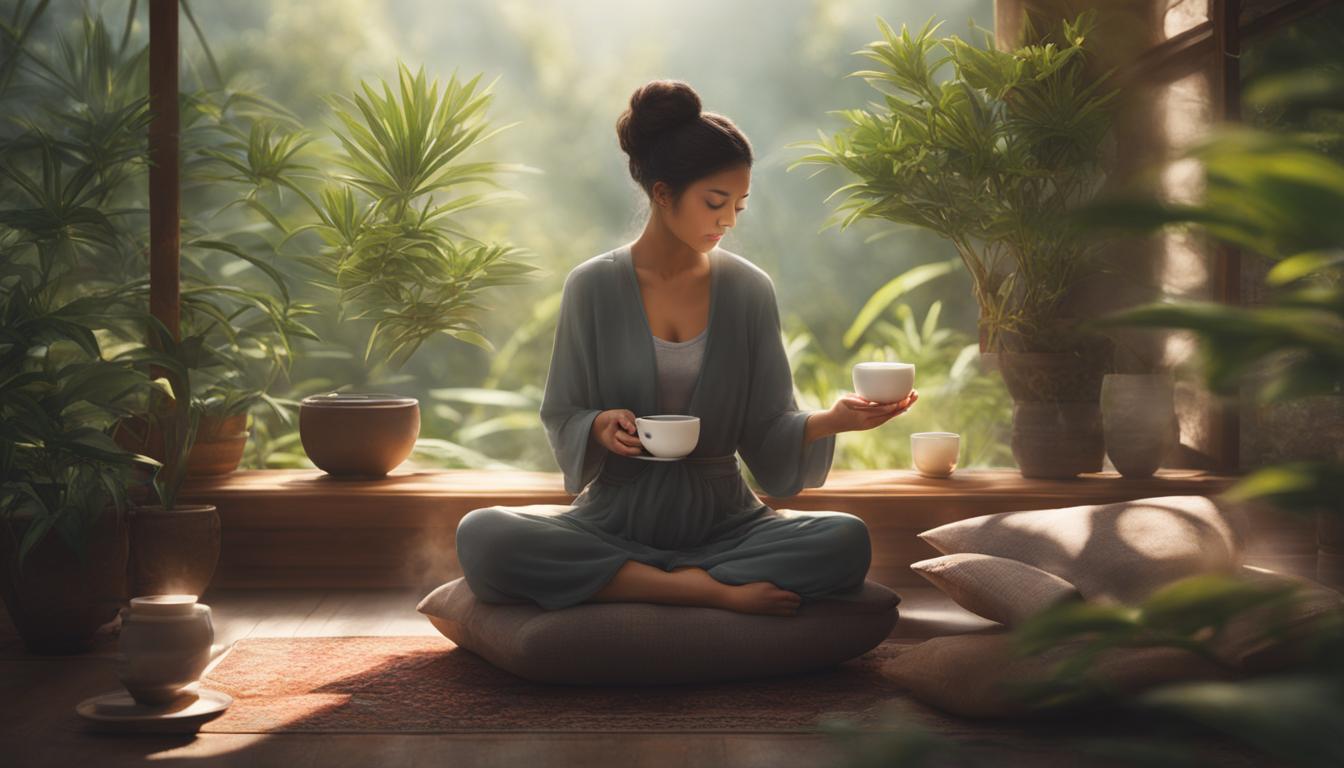
Tea Meditation Rituals and Practices
Tea meditation offers a beautiful and serene way to embrace mindfulness. With its rich history and diverse cultural traditions, tea meditation can be adapted to suit personal preferences and individual rituals. One of the fundamental practices in tea meditation is the mindful selection and preparation of tea.
“Selecting a tea that resonates with you is the first step towards a mindful tea meditation practice,” shares Jennifer Smith, a tea connoisseur. “Pay attention to the aroma and appearance of the tea leaves as you carefully scoop them into the teapot. Allow yourself to be fully present in the moment, appreciating the colors, textures, and scents.”
During the preparation process, the act of measuring the tea leaves, boiling the water, and pouring it into the teapot can all be done with a sense of awareness and intention. Take the time to notice the sound of the boiling water and the warmth as it fills the teapot. As the tea steeps, embrace the anticipation and let the aroma envelop your senses.
“Tea meditation is a beautiful practice of mindfulness,” says David Lee, a meditation teacher. “Sipping the tea mindfully allows us to fully engage with its flavors and textures. Every sip becomes an opportunity to be fully present in the moment, savoring the sensations that the tea brings.”
As you savor each sip, focus on the taste and the way it feels in your mouth. Embrace the warmth and allow it to relax your body and mind. Notice any thoughts or distractions that arise but gently bring your attention back to the tea. This process of consciously sipping and returning to the present moment can deepen your tea meditation experience.
Enhancing the Tea Meditation Experience
In addition to the mindful selection and preparation of tea, there are various rituals and techniques that can enhance the tea meditation experience. These practices can help create a sacred and intentional space for tea meditation and deepen the connection with the present moment.
“Using specific utensils, such as a traditional tea set or a favorite tea cup, can add a sense of reverence and intention to your practice,” suggests Michelle Chen, a tea enthusiast and expert. “The act of holding and drinking tea with a particular vessel can help create a mindful connection with the tea and its essence.”
Some practitioners incorporate specific movements or gestures into their tea meditation practice. These movements can range from simple gestures of pouring and steeping to more elaborate motions that enhance the overall ritual. The physical movements become an extension of the mindfulness practice, allowing for a deeper connection with the tea and the present moment.
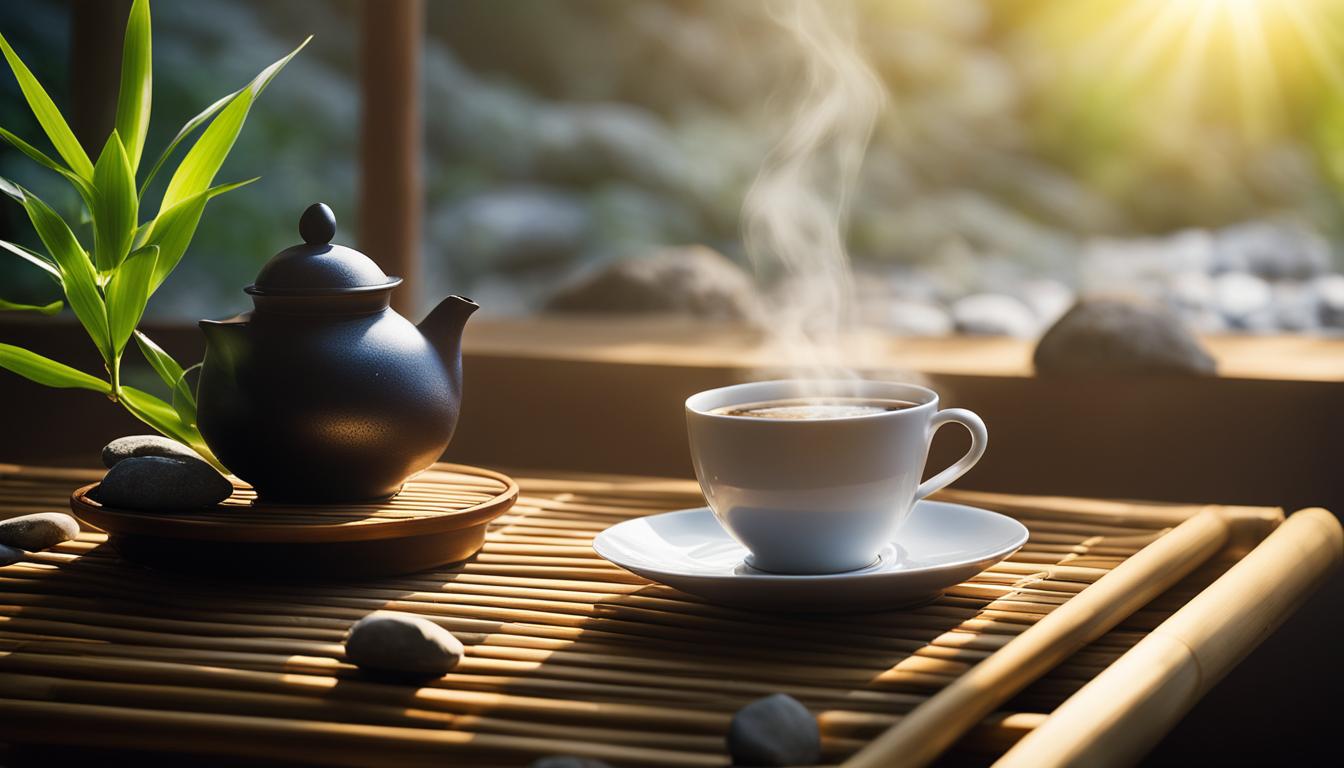
“Tea meditation rituals and practices are deeply personal and can vary from person to person,” says Sarah Johnson, a tea meditation enthusiast. “Experiment with different techniques and find what resonates with you. The key is to approach each step of the process with mindfulness and intention, allowing the tea to become a vehicle for inner calm and self-reflection.”
In the next section, we will explore the connection between tea and inner calm, diving deeper into the soothing effects of tea on our mind and body.
The Connection Between Tea and Inner Calm
Tea has long been associated with a sense of tranquility and inner calm. The act of preparing and drinking tea mindfully can create a peaceful space within and help us slow down and reconnect with ourselves.
The sensory experience of tasting tea, feeling its warmth, and appreciating its aroma can bring us into the present moment and quiet the mind. Tea contains natural compounds, such as L-theanine, which promote relaxation and reduce stress, further enhancing its connection to inner calm.
By taking the time to truly experience and savor a cup of tea, we can find a moment of respite and relaxation in our busy lives. The ritual of brewing and enjoying tea can become a meditative practice that brings us back to the present, allowing us to let go of worries and find a sense of peace.
“There is something magical about the way tea can help us find our inner calm. It’s a gentle reminder to slow down, breathe, and be fully present in the moment,” says tea expert Sarah Thompson.
Whether it’s a steaming cup of herbal tea before bed or a delicate green tea enjoyed in the afternoon, tea has a remarkable ability to soothe the senses and create a serene atmosphere. It offers a brief escape from the demands of everyday life, inviting us to relax and rejuvenate.
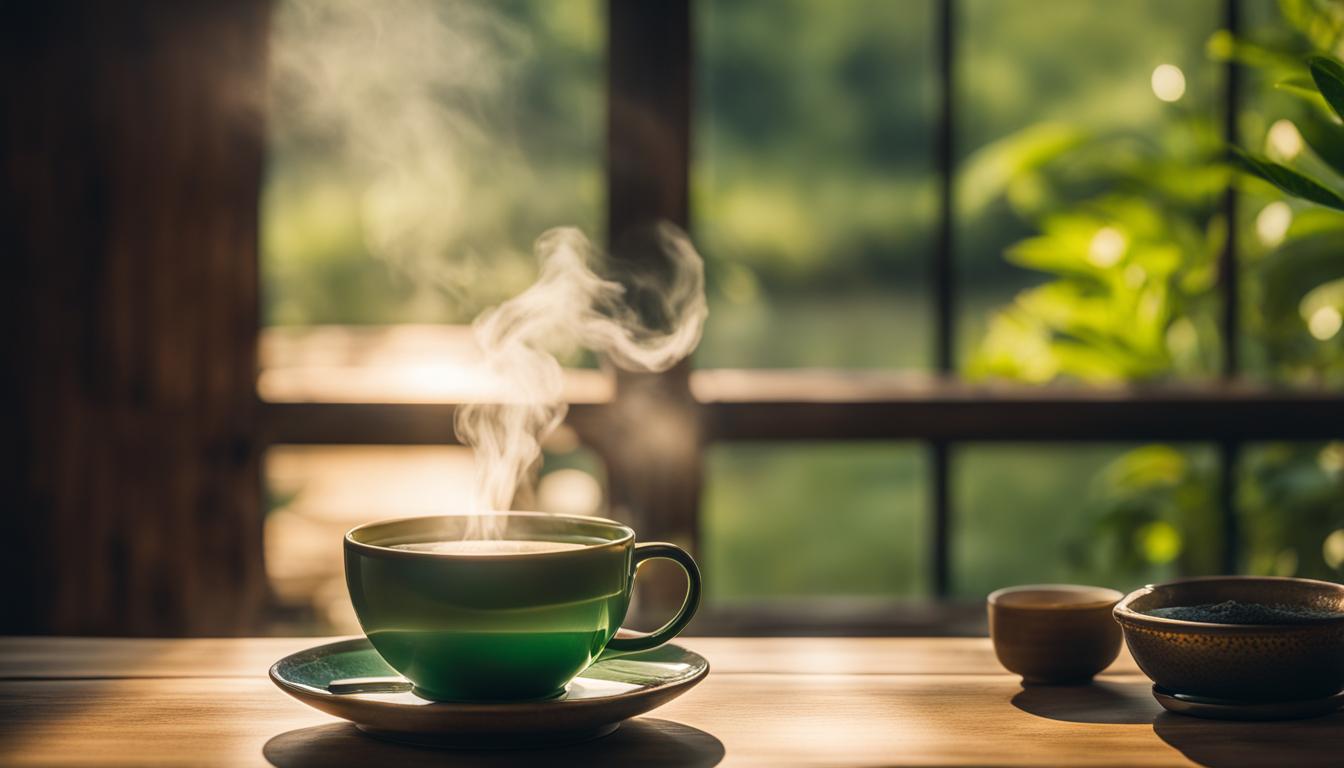
Exploring Different Types of Teas for Meditation
When it comes to tea meditation, the options are endless. Different types of teas offer unique flavors and therapeutic properties, allowing you to customize your meditation experience. Whether you are looking for a calming tea or one that promotes relaxation, there is a tea that resonates with you.
Green teas, particularly those from the Indian Himalayan region, are often recommended for meditation due to their high content of antioxidants and amino acids. These teas can promote a sense of focus and clarity, enhancing your mindfulness practice. The delicate flavors and soothing aroma of green teas can create a peaceful environment, allowing you to immerse yourself in the present moment.
Herbal teas, such as chamomile or peppermint, are known for their calming properties. These teas can help soothe the mind, reduce stress, and create a sense of tranquility during your meditation session. The gentle and comforting flavors of herbal teas can create a meditative space that promotes relaxation and inner peace.
Discovering Your Perfect Tea
The choice of tea for meditation ultimately depends on your personal preferences and the desired effect. Take the time to explore different types of teas and notice how they make you feel. Pay attention to the flavors, aromas, and sensations that each tea brings. Allow yourself to be guided by your intuition and choose the teas that resonate with you.
Here are some popular teas that are often recommended for tea meditation:
Green Tea: Offers a balance of refreshing flavors and calming properties. Look for high-quality green teas from reputable sources.
White Tea: Known for its delicate and subtle flavors, white tea can enhance your sense of mindfulness and relaxation.
Oolong Tea: A versatile tea that offers a range of flavors, oolong tea can provide a meditative experience that awakens the senses.
Herbal Teas: Chamomile, lavender, and peppermint teas are popular choices for their calming and soothing effects.
Remember, the essence of tea meditation is not solely in the tea itself, but in the act of mindfully preparing and savoring it. The journey of discovering your perfect tea for meditation is part of the experience, allowing you to deepen your connection with yourself and the present moment.
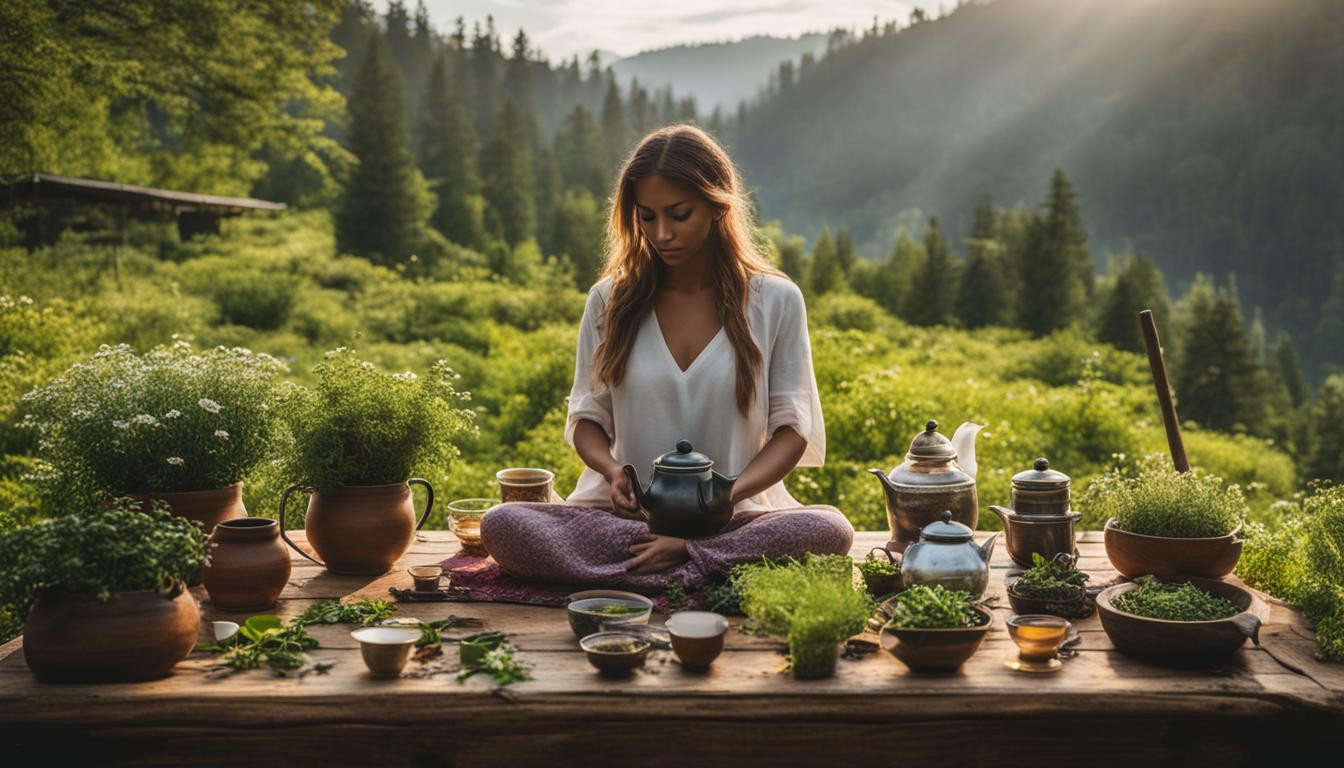
Incorporating Tea Meditation into Your Daily Routine
Incorporating tea meditation into your daily routine can be a transformative practice that brings mindfulness and well-being into your life. By dedicating time and creating a sacred space for tea meditation, you can find moments of peace and introspection amidst the busyness of life.
Begin by setting aside dedicated time for tea meditation. Whether it’s in the morning, afternoon, or evening, carving out this time allows you to fully immerse yourself in the practice. Treat it as a personal ritual and prioritize it as an essential part of your day.
Create a dedicated space for tea meditation. It can be a cozy corner in your home, a serene outdoor spot, or even a designated area on your desk at work. This space should be free from distractions and evoke a sense of calmness and tranquility.
Approach tea preparation mindfully. Pay attention to each step of the process, from the selection of your tea leaves to the boiling of water and the brewing of your tea. Engage all your senses as you inhale the aroma, feel the warmth of the tea, and savor each sip.
Throughout the day, consider incorporating mini tea meditation sessions as breaks. Taking short pauses to prepare and enjoy a cup of tea can help you reconnect with the present moment and recharge your mind and body.
Remember, tea meditation is a practice, and like any practice, it takes time to cultivate. Be patient with yourself and allow the process to unfold naturally. As you make tea meditation a regular part of your routine, you’ll start to experience its profound benefits in your everyday life.
Tips for a Successful Tea Meditation Practice
To make the most of your tea meditation practice, here are some tips that can enhance your experience:
-
- Choose high-quality teas: Selecting teas of the highest quality ensures that you will have a flavorful and enjoyable meditation experience. Look for teas that are freshly harvested and sourced from reputable suppliers.
-
- Experiment with different brewing methods: Explore various brewing techniques, such as gongfu style or using a traditional teapot, to find the method that suits you best. Each brewing method can bring out unique flavors and aromas in the tea.
-
- Practice non-attachment: Let go of any expectations or outcomes during your tea meditation practice. Embrace the present moment and allow yourself to fully immerse in the experience without judgment or attachment to specific results.
-
- Engage your senses: Pay attention to the sensory aspects of tea meditation, including the aroma, taste, texture, and appearance of the tea. Awaken your senses and fully indulge in the multisensory experience.
- Cultivate gratitude: Develop a sense of appreciation for the tea and the moments of stillness it brings to your life. Practice gratitude for the opportunity to engage in self-care and nourish your mind, body, and soul.
By following these tips, you can create an optimal environment for mindfulness and fully immerse yourself in the tea meditation experience. Remember, each meditation practice is unique, and it’s essential to find what works best for you.
“Tea meditation is not just about achieving mindfulness but embarking on a journey of self-discovery.”
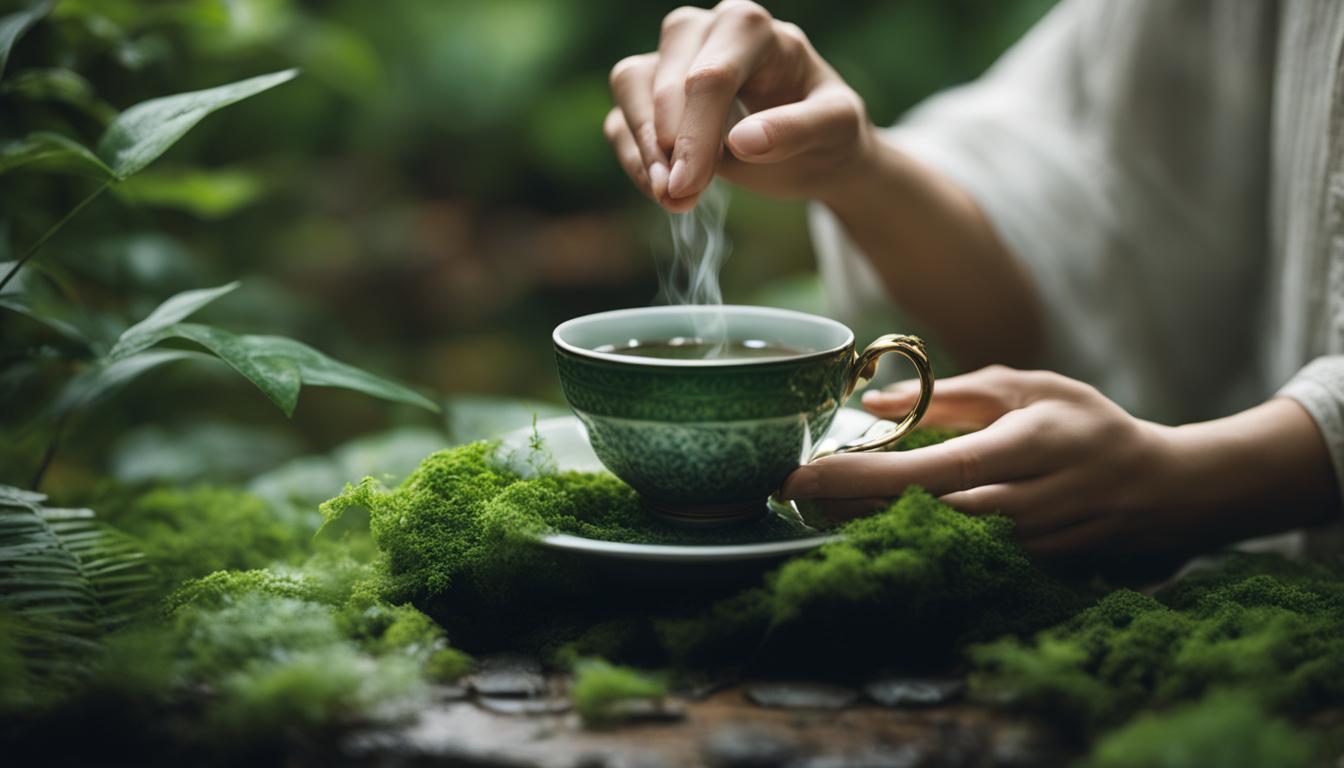
The Art of Mindfulness and Tea Meditation
Mindfulness is the art of being fully present in the moment, and tea meditation is a practice that naturally complements mindfulness. Both practices encourage a sense of awareness and appreciation for the simple pleasures of life.
Tea meditation offers a tangible and sensory experience that can anchor individuals in the present moment, while mindfulness provides a mindset of non-judgment and acceptance. When combined, they create a powerful synergy that can lead to a more balanced and centered life.
The Benefits of Mindfulness Practices
Practicing mindfulness has been scientifically proven to reduce stress, improve focus, and increase overall well-being. By cultivating a present-moment awareness, individuals can enhance their mental and emotional resilience. Mindfulness practices, such as meditation, breathing exercises, and body scans, bring a sense of calm and clarity to the mind.
The Art of Tea Meditation
Tea meditation takes mindfulness to another level by incorporating the ritual of preparing and savoring tea. It invites individuals to engage all their senses in the experience, from the aroma of the tea leaves to the warmth of the cup in their hands. Tea meditation is a practice that honors the beauty of simplicity and encourages individuals to find peace and stillness within themselves.
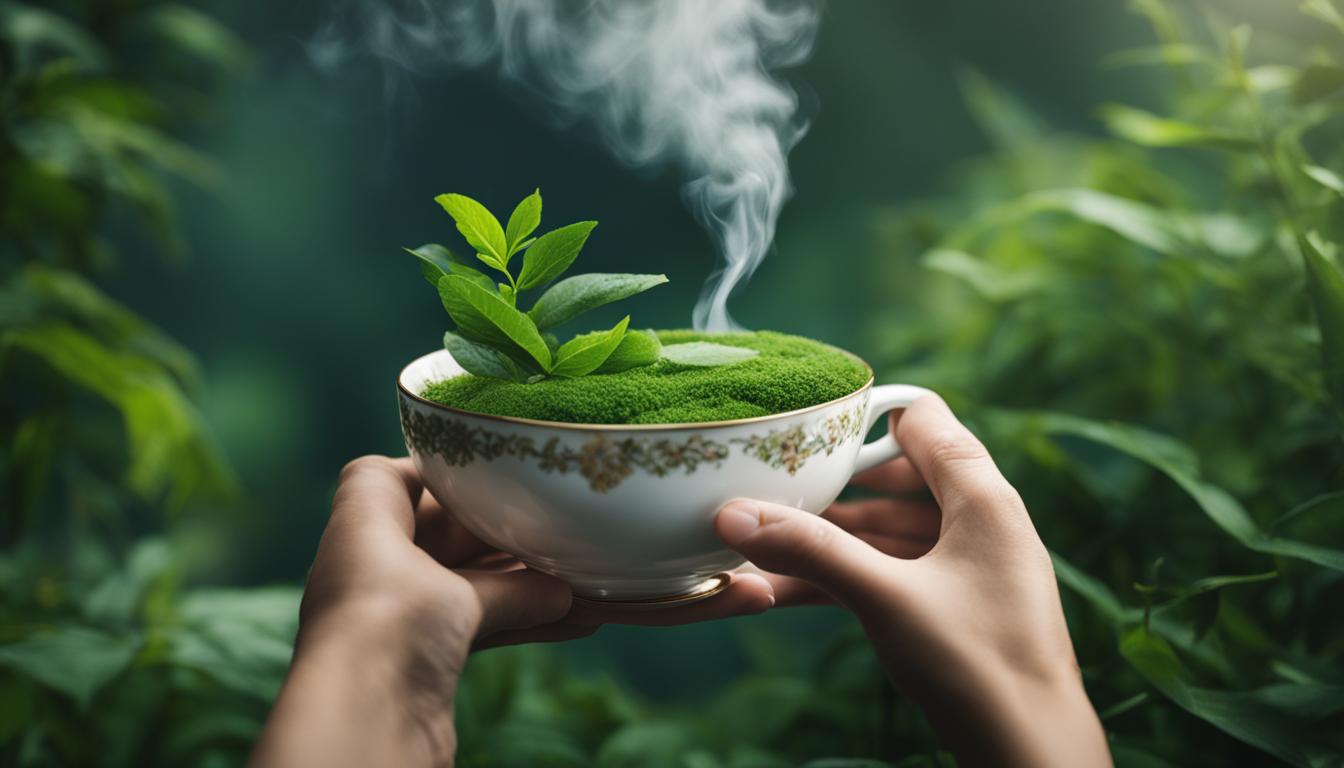
As you sit down with a cup of tea, take a moment to appreciate the present. Close your eyes, breathe in the soothing aroma, and let the warmth of the cup comfort your hands. With each sip, savor the taste and texture of the tea. Allow yourself to fully immerse in the moment, experiencing the journey of flavors and sensations.
A Mindful Pause in a Busy World
In a world that often feels fast-paced and overwhelming, tea meditation provides a much-needed pause. It offers a sanctuary of calm amidst the chaos, allowing individuals to reconnect with themselves and find solace in the present moment. By incorporating tea meditation into daily routines, individuals can create a sacred space for themselves, engage in self-care, and find moments of tranquility.
“Tea meditation offers a tangible and sensory experience that can anchor individuals in the present moment, while mindfulness provides a mindset of non-judgment and acceptance.”
Bringing Mindfulness into Everyday Life
Mindfulness is not confined to formal meditation sessions; it can be integrated into every aspect of our lives, including our tea-drinking rituals. Instead of rushing through a cup of tea, we can approach it with mindfulness and fully appreciate the experience.
Whether it’s taking a mindful tea break at work, enjoying a quiet moment alone, or sharing tea with loved ones, incorporating mindfulness into tea-drinking can transform an ordinary act into a meaningful and nourishing ritual.
By embracing the art of mindfulness and tea meditation, we can cultivate a deeper sense of presence, gratitude, and connection with ourselves and the world around us. So, the next time you sit down with a cup of tea, take a moment to be fully present, and let the gentle sip of tea become a gateway to inner peace and tranquility.
The Synergy of Tea and Meditation
Tea and meditation have a profound synergy, as both practices support relaxation and a sense of calm. When combined, tea and meditation create a harmonious union that enhances the benefits of each.
Tea, with its soothing properties and gentle energy, can prepare the mind and body for meditation. The act of preparing and sipping tea mindfully allows individuals to slow down and cultivate a sense of presence.
A quiet tea session can serve as a prelude to meditation, helping individuals transition into a state of mindfulness more smoothly. The process of making tea and savoring its calming effects can quiet the mind, allowing for a deeper and more serene meditation practice.
The meditative aspect of tea, coupled with the tranquil nature of meditation, creates a powerful synergy that promotes relaxation and inner peace. By incorporating tea into your meditation routine, you can deepen your mindfulness practice and experience a heightened sense of calm and clarity.

The Journey of Self-Discovery through Tea Meditation
Tea meditation is not just about achieving mindfulness but embarking on a journey of self-discovery. It offers an opportunity to connect with our true selves, find peace amidst the chaos of the world, and explore our inner landscape. The combination of tea and meditation provides a sanctuary of serenity in a fast-paced world, inviting us to slow down, engage our senses, and cultivate mindfulness. This gentle and accessible practice can become a cherished part of daily life, guiding individuals towards a more balanced and centered existence.
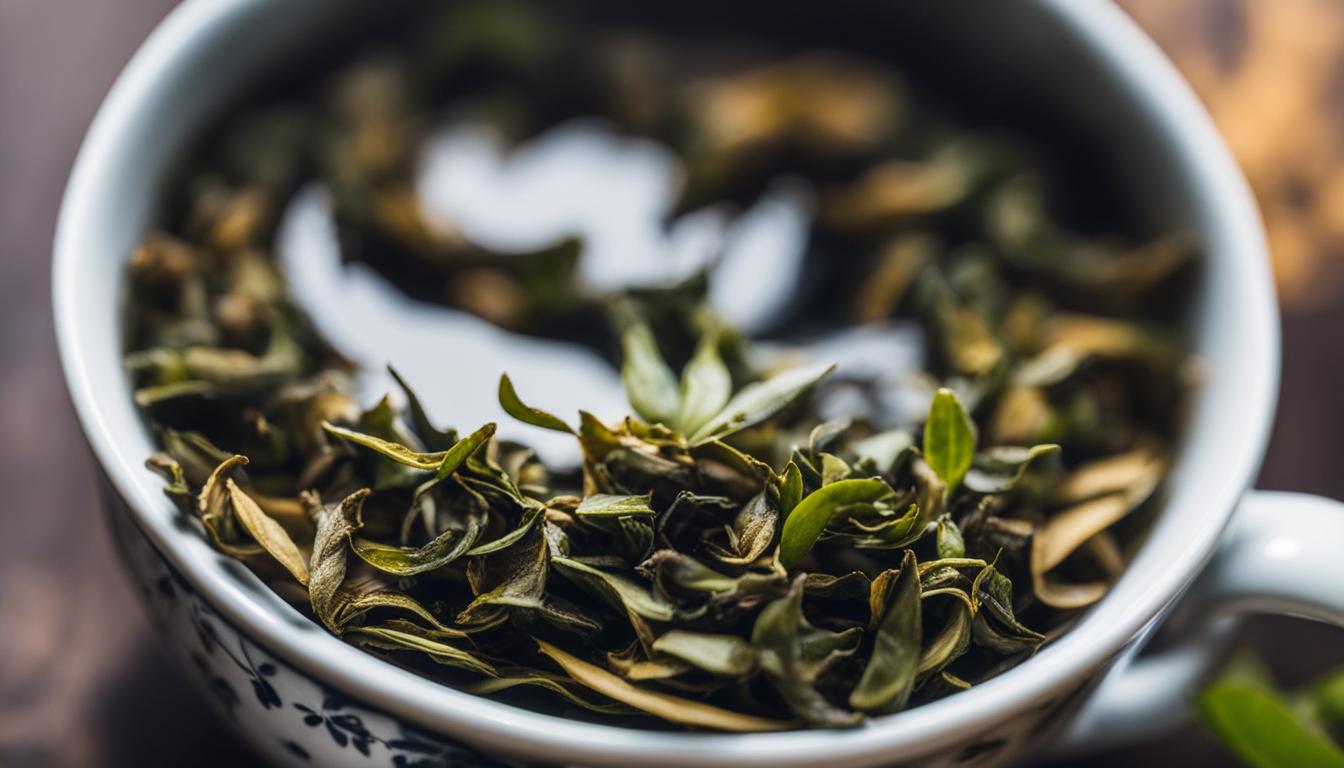
Conclusion
Tea meditation is a powerful practice that combines mindfulness with the art of tea, offering a pathway to inner calm and peace. Originating from ancient cultures, this practice has stood the test of time and continues to provide numerous benefits for mindfulness and overall well-being.
By incorporating tea meditation into your daily routine, you can create a sacred space for yourself amidst the busyness of life. This practice encourages self-care and moments of tranquility, allowing you to slow down, be fully present, and find moments of serenity.
Through the combination of tea and meditation, individuals have the opportunity to embark on a journey of self-discovery. By engaging your senses and cultivating mindfulness, you can create a more balanced and centered existence. Embrace the practice of tea meditation and experience the serenity it can bring to your life.
FAQ
What is tea meditation?
Tea meditation is a practice that combines mindfulness with the art of tea, allowing individuals to find inner calm and peace.
Where does tea meditation originate from?
Tea meditation has its roots in ancient cultures, particularly in China and Japan, where tea has been used for centuries in meditation practices.
What are the benefits of tea meditation for mindfulness?
Engaging all our senses in the process of preparing and savoring tea can help reduce stress, promote relaxation, and cultivate a greater sense of calm, clarity, and overall well-being.
How can tea meditation be practiced?
Tea meditation can be practiced in various ways, depending on personal preferences and cultural traditions. One common practice is to select a tea mindfully and pay attention to each step of the preparation process.
What is the connection between tea and inner calm?
Tea has long been associated with a sense of tranquility and inner calm. The act of preparing and drinking tea mindfully can create a peaceful space within and help us slow down and reconnect with ourselves.
What types of teas are recommended for tea meditation?
Different types of teas offer unique flavors and therapeutic properties. Green teas, particularly those from the Indian Himalayan region, are often recommended for meditation due to their high content of antioxidants and amino acids.
How can tea meditation be incorporated into a daily routine?
By creating a dedicated space, setting aside dedicated time, and approaching tea preparation mindfully, individuals can incorporate tea meditation into their daily routine.
Are there any tips for a successful tea meditation practice?
Choosing high-quality teas, experimenting with different brewing methods, engaging your senses, and cultivating gratitude are all ways to deepen your tea meditation practice.
What is the relationship between mindfulness and tea meditation?
Mindfulness is the art of being fully present in the moment, and tea meditation is a practice that naturally complements mindfulness, both encouraging a sense of awareness and appreciation for the simple pleasures of life.
What is the synergy between tea and meditation?
Tea and meditation have a profound synergy, as both practices support relaxation and a sense of calm. The quiet tea session can serve as a prelude to meditation, helping individuals transition into a state of mindfulness more smoothly.
Can tea meditation be a journey of self-discovery?
Yes, tea meditation offers an opportunity to connect with our true selves, find peace amidst the chaos of the world, and explore our inner landscape. It provides a sanctuary of serenity in a fast-paced world.


